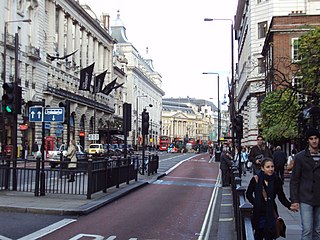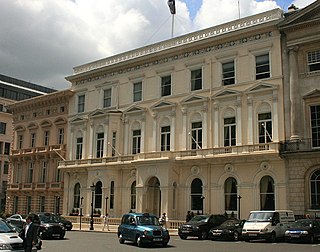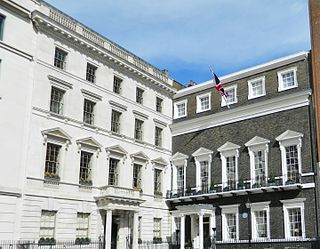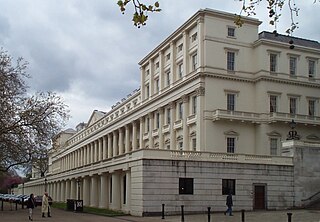
Piccadilly is a road in the City of Westminster, London, England, to the south of Mayfair, between Hyde Park Corner in the west and Piccadilly Circus in the east. It is part of the A4 road that connects central London to Hammersmith, Earl's Court, Heathrow Airport and the M4 motorway westward. St James's is to the south of the eastern section, while the western section is built up only on the northern side. Piccadilly is just under 1 mile (1.6 km) in length, and it is one of the widest and straightest streets in central London.

St James's is a central district in the City of Westminster, London, forming part of the West End. The area was once part of the northwestern gardens and parks of St. James's Palace. During the Restoration in the 17th century, the area was developed as a residential location for the British aristocracy, and around the 19th century was the focus of the development of their gentlemen's clubs. Once part of the parish of St Martin in the Fields, much of it formed the parish of St James from 1685 to 1922. Since the Second World War the area has transitioned from residential to commercial use.

Badminton is a village and civil parish in South Gloucestershire, England. The only settlement in the parish is Badminton village, sometimes called Great Badminton to distinguish it from the hamlet of Little Badminton, about one mile to the north in Hawkesbury parish. The large country house called Badminton House is close to the north end of the village, and its surrounding deer park lies to the north and west.

Badminton House is a large country house and Grade I Listed Building in Badminton, Gloucestershire, England, which has been the principal seat of the Dukes of Beaufort since the late 17th century. The house, which has given its name to the sport of badminton, is set among 52,000 acres (21,000 ha) of land. The gardens and park surrounding the house are listed at Grade I on the Register of Historic Parks and Gardens.

The East India Club is a gentlemen's club founded in 1849 and situated at 16, St James's Square in London. The full title of the club is East India, Devonshire, Sports and Public Schools' Club due to mergers with other clubs. The club was originally founded for officers of the East India Company, and its first Patron was Prince Albert.

Henry Hugh Arthur FitzRoy Somerset, 10th Duke of Beaufort, styled Marquess of Worcester until 1924, was a peer, landowner, society figure and a great authority in the fields of horse racing and fox-hunting. He held the office of Master of the Horse for over forty years (1936–1978), the longest to hold the position. He founded the Badminton Horse Trials and was deemed "the greatest fox-hunter of the twentieth century"; his long tenure as Master of the Beaufort Hunt led to his being universally nicknamed Master and his car bore the private numberplate MFH1. In 1980 he published the authoritative book Fox-Hunting.

The Devonshire Club was a London gentlemen's club which was established in 1874 and was disbanded in 1976. Throughout its existence it was based at 50 St James's Street. The major Liberal club of the day was the Reform Club, but in the wake of the Reform Act 1867's extension of the franchise, the waiting list for membership from the larger electorate grew to such an extent that a new club was formed to accommodate these new Liberal voters. The clubhouse was on the western side of St James's Street. The original intention was to call it the 'Junior Reform Club', along the model of the Junior Carlton Club formed in 1866, but complaints from the Reform Club's members led it to being named the Devonshire, in honour of its first chairman, the Duke of Devonshire, an aristocrat from a long line of Liberals.

St James's Street is the principal street in the district of St James's, central London. It runs from Piccadilly downhill to St James's Palace and Pall Mall. The main gatehouse of the Palace is at the southern end of the road; in the 17th century, Clarendon House faced down the street across Piccadilly from the site of what is now Albemarle Street.

The Caledonian Club is a prestigious Scottish-focused London members' club located at 9 Halkin Street SW1, near Belgrave Square in Belgravia, London, SW1.

Dover Street is a street in Mayfair, London. The street is notable for its Georgian architecture as well as the location of historic London clubs and hotels, which have been frequented by world leaders and historic figures in the arts. It also hosts a number of contemporary art galleries. An equestrian sculpture by Elisabeth Frink stands on the junction of Dover Street and Piccadilly, opposite the Ritz Hotel.

Den Norske Klub is a social club based in London. It was founded on 17 May 1887. Its members are Norwegians living in London or Britons with a connection to or interest in Norway. It is the oldest club of its kind in the UK and is still an important meeting place for the Norwegian community in London.
The Guards Club, established in 1810, was a London Gentlemen's club for officers of the Guards Division, originally defined by the club as being the Coldstream Guards, Grenadier Guards or Scots Guards, traditionally the most socially elite section of the British Army. Officers of the Welsh and Irish Guards were not able to join until the second half of the 20th century. Its clubhouse at 70 Pall Mall was the first to be built on that street, which later became noted for its high concentration of clubs; earlier clubs had been focused on the adjoining St James's Street.

The Turf Club is a London gentlemen's club, established in 1861 as the Arlington Club. It has been located at 5, Carlton House Terrace since 1965.

Pratt's is a gentlemen's club in London, England. It was established in 1857, with premises in a house in Park Place, off St James's Street, and close to the Ritz.

The St James's Club was a London gentlemen's club which operated between 1857 and 1978. It was founded by two leading diplomats and its members continued to be largely diplomats and authors. It was first established in Bennet Street, and after a brief spell in Mayfair, moved to 106 Piccadilly by 1868. In the final quarter of the twentieth century many gentlemen’s clubs of London suffered from declining membership, and in 1978 the St James's Club merged with Brooks's Club and vacated its premises.

The Green Room Club was a London-based club, primarily for actors, but also for lovers of theatre, arts and music. It was established in 1877 in a restaurant in Piccadilly Circus, and moved to premises on Adam Street in 1955, where it remained until its closure in 2004.
Arthur's was a London gentlemen's club, now dissolved, which was established in 1811 and was disbanded in 1940. Between 1827 and 1940 it was based at 69 St James's Street. It is now best remembered for having built the London clubhouse currently occupied by the Carlton Club.

The Burlington Fine Arts Club was a London gentlemen's club based at 17 Savile Row.

The Cavalry and Guards Club is a London gentlemen's club, at 127 Piccadilly, situated next to the RAF Club.

The Public Schools Club is a former London gentlemen's club.


















